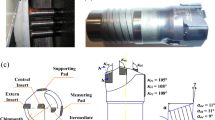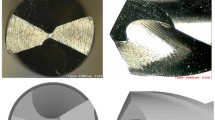Abstract
This paper presents a new burr formation model for predicting drilling burr sizes in consideration of tool wear. A new force model is established by combining the drilling thrust force with the ploughing force caused by tool wear. The traditional drilling burr formation model is modified by using the new force model to determine burr heights and thicknesses in terms of tool wear percentage. A series of drilling experiments are carried out on two commonly used aerospace aluminiums to validate and calibrate the model. A close agreement between simulation and experiment is achieved showing that burr height and thickness increase with the increase in tool wear, and at 50% of tool wear, the maximum burr height could triple and the maximum burr thickness could double.












Similar content being viewed by others
Availability of data and materials
The data generated and analysed during this study are included in this paper.
Change history
28 April 2021
Springer Nature’s version of this paper was updated to include e-mail address of the first author.
References
Lauderbaugh LK (2009) Analysis of the effects of process parameters on exit burrs in drilling using a combined simulation and experimental approach. J Mater Process Technol 209:1909–1919
Dornfeld DA, Kim JS, Dechow V, Hewson J, Chen LJ (1999) Drilling burr formation in titanium alloy Ti-6AI-4V. CIRP Ann Manuf Technol 48:73–76
Kim JS, Dornfeld DA (2002) Development of an analytical model for drilling burr formation in ductile materials. J Eng Mater Technol 124:192–198
Leopold J, Wohlgemuth R (2010) Modeling and simulation of burr formation: state-of-the-art and future trends. In: Aurich JC, Dornfeld D (eds) Burrs – analysis, control and removal. Springer, Heidelberg, pp 79–86
Brinksmeier E, Fangmann S (2010) Burr and cap formation by orbital drilling of aluminum. In: Aurich JC, Dornfeld D (eds) Burrs – analysis, control and removal. Springer, Heidelberg, pp 31–45
Gaitonde VN, Karnik SR, Achyutha BT, Siddeswarappa B, Davim JP (2009) Predicting burr size in drilling of AISI 316L stainless steel using response surface analysis. Int J Mater Prod Technol 35:228–245
Waldorf DJ, DeVor RE, Kapoor SG (1998) A slip-line field for ploughing during orthogonal cutting. J Manuf Sci Eng 120:693–701
Chinchanikar S, Choudhury SK (2016) Cutting force modeling considering tool wear effect during turning of hardened AISI 4340 alloy steel using multi-layer TiCN/Al2O3/TiN-coated carbide tools. Int J Adv Manuf Technol 83:1749–1762
Kara F, Aslantas K, Cicek A (2016) Prediction of cutting temperature in orthogonal machining of AISI316L using artificial neural network. Appl Soft Comput 38:64–74
Long Y, Huang Y (2010) Combined effects of flank and crater wear on cutting force modeling in orthogonal machining, part I: model development. Mach Sci Technol 14:1–23
Long Y, Huang Y, Sun X (2010) Combined effects of flank and crater wear on cutting force modeling in orthogonal machining, part II: Bayesian approach-based model validation. Mach Sci Technol 14:24–42
Abdelhafeez AM, Soo SL, Aspinwall DK, Dowson A, Arnold D (2015) Burr formation and hole quality when drilling titanium and aluminium alloys. Procedia CIRP 37:230–235
ASM (1989) Machining of aluminum and aluminum alloys. In: ASM handbook vol. 16, machining, 9th edn. ASM International, Materials Park, pp 761–765
Öztürk B, Kara F (2020) Calculation and estimation of surface roughness and energy consumption in milling of 6061 alloy. Adv Mater Sci Eng. https://doi.org/10.1155/2020/5687951
Clarkson-Osborn Tools Limited (2014) HSS & carbide metal cutting tools catalogue. Clarkson-Osborn Tools Ltd, Brampton
Franke V, Leitz L, Aurich JC (2010) Burr measurement: a round robin test comparing different methods. In: Aurich JC, Dornfeld D (eds) Burrs – analysis, control and removal. Springer, Heidelberg, pp 167–178
Funding
This research is supported by the Natural Sciences and Engineering Research Council of Canada and the Zhejiang Provincial Natural Science Foundation of China (Grant No. LGG18E050018).
Author information
Authors and Affiliations
Contributions
1st author: PhD work; 2nd author: model improvement; 3rd author: PhD supervisor.
Corresponding author
Ethics declarations
Ethical approval
N/A
Consent to participate
Yes
Consent to publish
Yes
Competing interests
The authors declare no competing interests.
Additional information
Publisher’s note
Springer Nature remains neutral with regard to jurisdictional claims in published maps and institutional affiliations.
Rights and permissions
About this article
Cite this article
Mandra, A.M., Jiang, J. & Xi, F.(. A new burr formation model for drilling with tool wear. Int J Adv Manuf Technol 116, 1437–1450 (2021). https://doi.org/10.1007/s00170-021-07031-4
Received:
Accepted:
Published:
Issue Date:
DOI: https://doi.org/10.1007/s00170-021-07031-4




